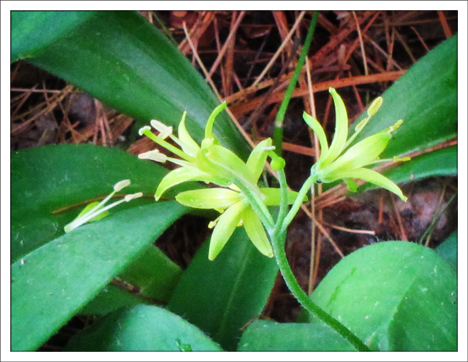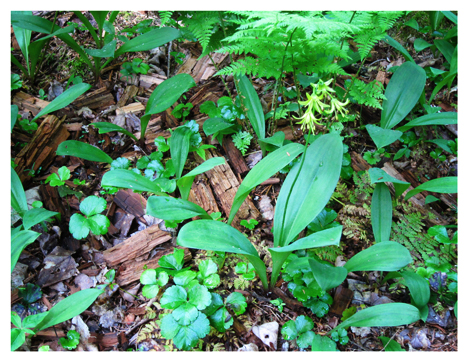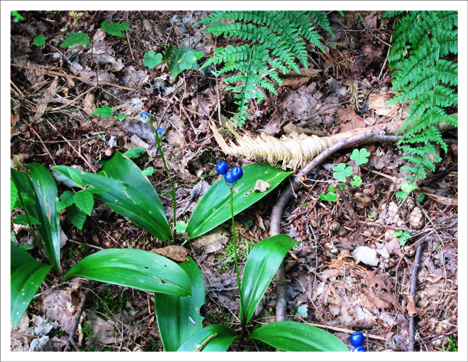Adirondack Wildflowers:
Clintonia (Clintonia borealis)
 Adirondack Wildflowers: Clintonia (Bluebead Lily) blooming at the Paul Smiths VIC (2 June 2012)
Adirondack Wildflowers: Clintonia (Bluebead Lily) blooming at the Paul Smiths VIC (2 June 2012)
| This page is no longer being updated. For an updated and expanded version of this material, see: Clintonia (Clintonia borealis). |
Clintonia (or Bluebead Lily) is a perennial member of the lily family that flourishes in the Adirdonacks. It grows in the cool acidic forests of northeastern and north central North America, ranging as far south as the mountains of North Carolina. Clintonia is sometimes considered a northern hardwood or boreal species; and occurs commonly with Indian Cucumber-root, Purple Trillium, Hobblebush, and Striped Maple. Clintonia can be found in a variety of shaded habitats, including dry to moist woods of all types, bogs, swamps, and rocky slopes. It is especially common in open birch/fir or spruce woods, throughout the north woods region. The plant is very common in mountainous areas. The common name is a reference to the porcelain blue berries produced in mid to late summer.
The
plants are colonial in nature; often found in great colonies of
medium green, glossy basal leaves. The leaves can reach 12 inches
in length, but are more commonly six to eight inches long and
are sometimes confused with wild leeks (Allium tricoccum) and
several orchid species including Pink
Lady's Slipper (Cypripedium acaule) and showy orchis (Orchis
spectabilis). A close look at the leaves shows the parallel veins
typical of all monocots, the group to which lilies belong.
 Adirondack Wildflowers: Clintonia (Bluebead Lily) in bloom at the Paul Smiths VIC (30 May 2012)
Adirondack Wildflowers: Clintonia (Bluebead Lily) in bloom at the Paul Smiths VIC (30 May 2012)
In spring and early summer, the plant produces 3-6 pale yellow, drooping, bell-like flowers. Each flower is 3/4" wide, with six pointed, petal-like segments surrounding six stamens. The plant is said to attract large numbers of Yellow Swallowtail butterflies. The flowering season is usually from late May through June.
 Adirondack Wildflowers: Blue berries of the Bluebead Lily at the Paul Smiths VIC (22 July 2012)
Adirondack Wildflowers: Blue berries of the Bluebead Lily at the Paul Smiths VIC (22 July 2012)
In midsummer, after the plant blooms, it produces berries that transition from green to white, and ultimately to a deep porcelain blue. Standing on stalks ranging from 4 to sometimes 16 inches in height, the berries stand out in sharp contrast to greens and browns of the forest floor. The berries are not poisonous, but they are quite foul tasting and should be avoided. Chipmunks and birds, however, are said to relish the berries.
The plant was named in honor of the former governor of New York, DeWitt Clinton (1769-1828). Clintonia may be seen at the Paul Smiths VIC along many of the trails. It usually begins blooming in late May.
References:
- Lady Bird Johnson Wildflower Center. Native Plant Database.
- United States Department of Agriculture. Plants Database
- US Forest Service Celebrating Wildflowers
- Anne McGrath. Wildflowers of the Adirondacks (EarthWords, 2000), p. 79.
- Doug Ladd, North Woods Wildflowers (Falcon Publishing, 2001), p. 124.
- William K. Chapman, et al. Wildflowers of New York in Color (Syracuse University Press, 1998), pp. 90-91.
- Lawrence Newcomb, Newcomb's Wildflower Guide (Little Brown and Company, 1977), pp. 338-339.
